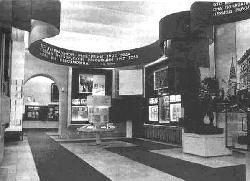The First Russian revolution (1905 - 1907)
The first Russian revolution hall in the lenin MuseumEarly Sunday morning, January 9 (22), 1905, the workers of St. Petersburg, carrying banners, icons and portraits of the tsar, solemnly marched to the Winter Palace, the residence of the tsar, with a petition in which they told of their unbearably difficult life. Many came with their wives and children. More than one hundred and forty thousand people took part in the procession. Upon the order of the tsar, this peaceful, unarmed procession was met by gunshot. More than one thousand people were killed, and almost five thousand were injured. The photographs portray the mass demonstrations against tsarism that took place in Moscow, St. Petersburg, Kiev, Ivanovo-Voznesensk, Krasnoyarsk and other cities. Here are the leaflets calling for uprising. I.Shadr's expressive sculpture, "The Cobblestone—the Weapon of the Proletariat" (1927), is also exhibited in the hall. Forced to live abroad at this time, Lenin took an active interest in the events in Russia and quickly responded to them. Among the exhibit items is the fourth issue of the newspaper Vpcryod, with Lenin's article, "The Beginning of the Revolution in Russia" in which he appraises the events of January 9: "The working class has received a momentous lesson in civil war; the revolutionary education of the proletariat made more progress in one day than it could have made in months and years of drab, humdrum, wretched existence." In April 1905 the Third Congress of the Russian Social-Democratic Labour Party took place in London defining the strategy and tactics of the Party in the bourgeois-democratic revolution and development of it Into a socialist revolution. A photograph of the delegates to the Congress hangs on the wall. Lenin's handwritten plans for resolutions about an armed revolt, about the provisional revolutionary government, and about support of the peasant movement are on display here. The first edition of V. I. Lenin's book, Two Tactics of Social-Democracy in the Democratic Revolution (June-July 1905), is found in the centre of this hall. In this book, the particulars of bourgeois-democratic revolution in the epoch of imperialism, its driving forces and prospects were disclosed. Lenin comprehensively substantiated the idea of the proletariat as predominant force in the bourgeois-democratic revolution, and worked out the theory of its development into a socialist revolution. Subsequent events confirmed the correctness of the decision made by the Third Congress of the RSDLP. The photographs, documents and Other materials on display portray the development of the revolutionary struggle in the spring and summer of 1905: the huge strikes in the industrial centres throughout the country, the peasant unrest, and the first barricades in the city streets. The army joined the political struggle. One of the photographs shows the battleship Potyomkin which raised the flag of mutiny in the Black Sea Fleet. A model of this battleship is placed in the centre of the hall. During the strikes the proletariat of Russia formed the first mass political proletarian organisations in world history, the Soviets of Workers' Deputies. Photographs of the strike in the city Ivanovo-Voznesensk are on exhibit. It was precisely here that workers founded the Soviet of Representatives, the first Soviet of Workers' Deputies-prototype of the Soviet power. V. I. Lenin longed for his native country. And the time had arrived in November 1905 he returned from emigration to St. Petersburg and started his tireless revolutionary activities. He directed the work of the central and St. Petersburg Bolshevik committees, made speeches at Party meetings and conferences in St. Petersburg and Moscow, met with Party workers and wrote articles for Bolshevik publications. Under his leadership an armed uprising was being prepared. On exhibit in the hall is the first legal Bolshevik newspaper Novaya Zhizn (New Life), headed by Lenin after his return to our country. He gathered about the newspaper, not only Party comrades dedicated to the work of the revolution but also splendid journalists and publicists: M.OIminsky, V.Vorovsky, A.Lunacharsky and M.Gorky. R.Luxemburg, K. Liebknecht, M. Cachin, P. Lafargue and others wrote for the newspaper. Lenin himself was a talented journalist and editor. He knew his reader and expressed himself precisely every time, finding a splendid form of exposition. Fourteen articles by Lenin were published in Novaya Zhizn. An issue with one of his most important articles is on display. The article is "Party Organisation and Party Literature"; here V. I. Lenin advanced and substantiated the principle of political commitment in literature. Progressive literature follows this principle to day. Newspapers and magazines from 1905 to 1907 which published Lenin's works are exhibited in the display case in the centre of the hall. The armed uprising in Moscow in December 1905 became the culmination of the Russian revolution. During a period of 9 days several thousand armed workers led a heroic struggle with the police and government troops. The map-diagram shows the locations of barricade battles and mass workers' actions in Moscow and other cities in Russia. Slides devoted to the Moscow uprising are demonstrated in this hall. The final part of this exposition is dedicated to the world-wide historic significance of the Russian revolution that took place from 1905 to 1907. See also: Anatoly Lunacharsky. Lenin
and Russian revolution. Fidel Castro October Revolution and Cuban Revolution and other historical documents and photos at the Defend Lenin mausoleum! site. Years of Reaction (1907-1910) |
 <"russian">
<"russian">